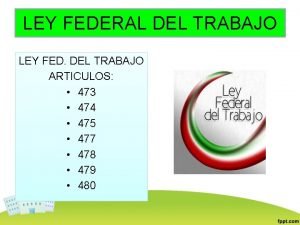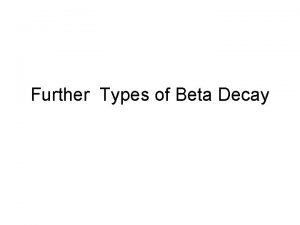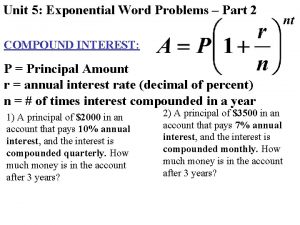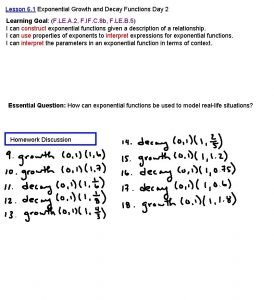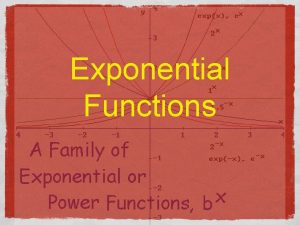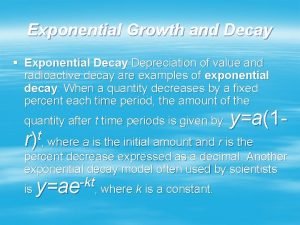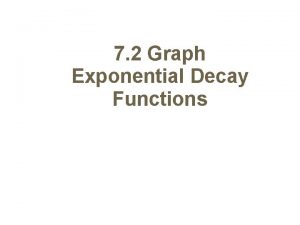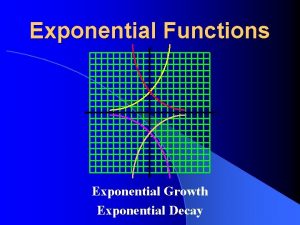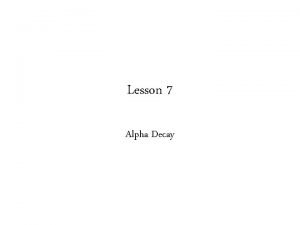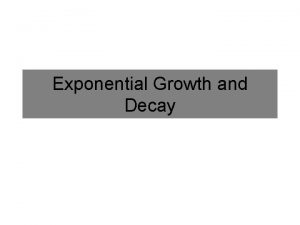8 2 Exponential Decay P 474 Exponential Decay













- Slides: 13

8. 2 Exponential Decay P. 474

Exponential Decay �Has the same form as growth functions f(x) = abx �Where a > 0 �BUT: � 0 < b < 1 (a fraction between 0 & 1)

Recognizing growth and decay functions �State whether f(x) is an exponential growth or decay function �f(x) = 5(2/3)x �b=2/3, 0<b<1 it is a decay function. �f(x) = 8(3/2)x �b= 3/2, b>1 it is a growth function. �f(x) = 10(3)-x �rewrite as f(x)=10(1/3)x so it is decay

Recall from 8. 1: �The graph of y= abx �Passes thru the point (0, a) (the y intercept is a) �The x-axis is the asymptote of the graph �a tells you up or down �D is all reals (the Domain) �R is y>0 if a>0 and y<0 if a<0 �(the Range)

Graph: y = 3(1/4)x Plot (0, 3) and (1, 3/4) Draw & label asymptote Connect the dots using the asymptote y=0 Domain = all reals Range = reals>0

Graph y = -5(2/3)x Plot (0, -5) and (1, 10/3) Draw & label asymptote Connect the dots using the asymptote y=0 Domain : all reals Range : y < 0

Now remember: To graph a general Exponential Function: �y = a bx-h + k �Sketch y = a bx �h= ? ? ? k= ? ? ? �Move your 2 points h units left or right …and k units up or down �Then sketch the graph with the 2 new points.

Example graph y=-3(1/2)x+2+1 Lightly sketch y=- 3·(1/2)x Passes thru (0, -3) & (1, -3/2) h=-2, k=1 Move your 2 points to the left 2 and up 1 AND your asymptote k units (1 unit up in this case)

y=1 Domain : all reals Range : y<1

Using Exponential Decay Models �When a real life quantity decreases by fixed percent each year (or other time period), the amount y of the quantity after t years can be modeled by: �y = a(1 -r)t �Where a is the initial amount and r is the percent decrease expressed as a decimal. �The quantity 1 -r is called the decay factor

Ex: Buying a car! �You buy a new car for $24, 000. �The value y of this car decreases by 16% each year. �Write an exponential decay model for the value of the car. �Use the model to estimate the value after 2 years. �Graph the model. �Use the graph to estimate when the car will have a value of $12, 000.

�Let t be the number of years since you bought the car. �The � � � model is: y = a(1 -r)t = 24, 000(1 -. 16)t = 24, 000(. 84)t Note: . 84 is the decay factor �When t = 2 the value is y=24, 000(. 84)2 ≈ $16, 934

Now Graph The car will have a value of $12, 000 in 4 years!!!
 Ley fed del trabajo
Ley fed del trabajo Cecs 474
Cecs 474 Cecs 474
Cecs 474 Art 474 lft
Art 474 lft Topology in computer network
Topology in computer network Cse 474
Cse 474 Types of beta decay
Types of beta decay Decay factor and decay rate
Decay factor and decay rate Exponential decay function
Exponential decay function Growth or decay exponential
Growth or decay exponential Lesson 6 exponential growth
Lesson 6 exponential growth 4-1 exponential functions growth and decay
4-1 exponential functions growth and decay Growth and decay formula
Growth and decay formula Domain exponential function
Domain exponential function
